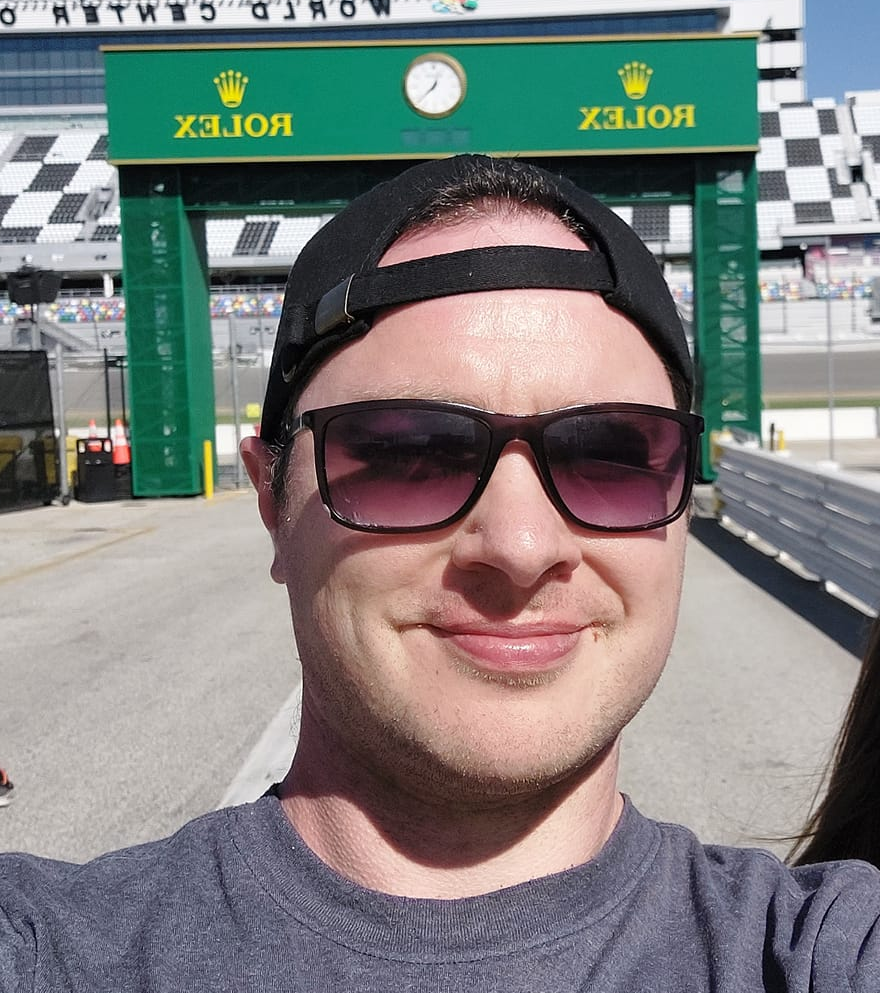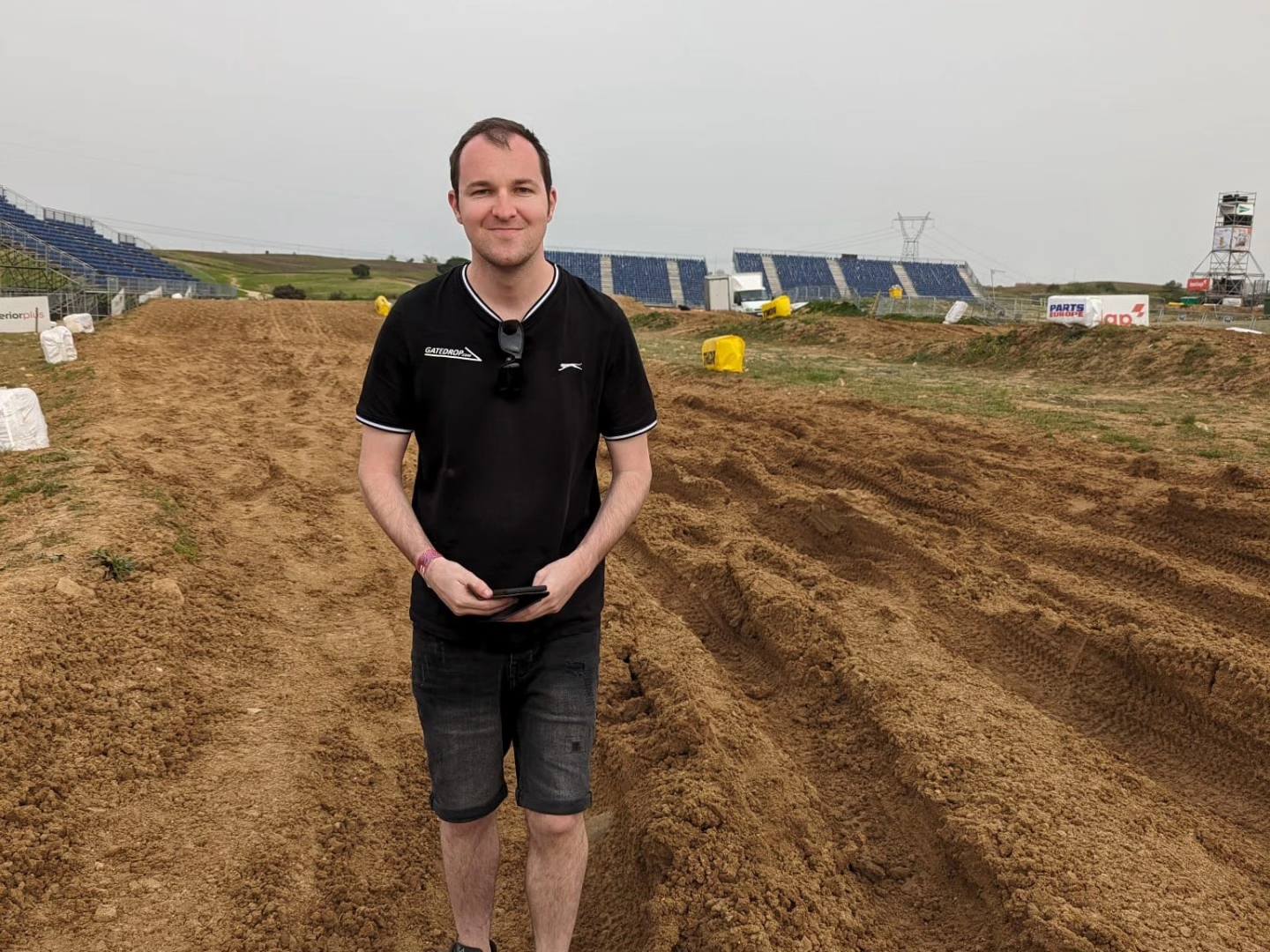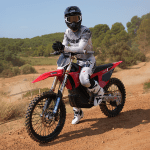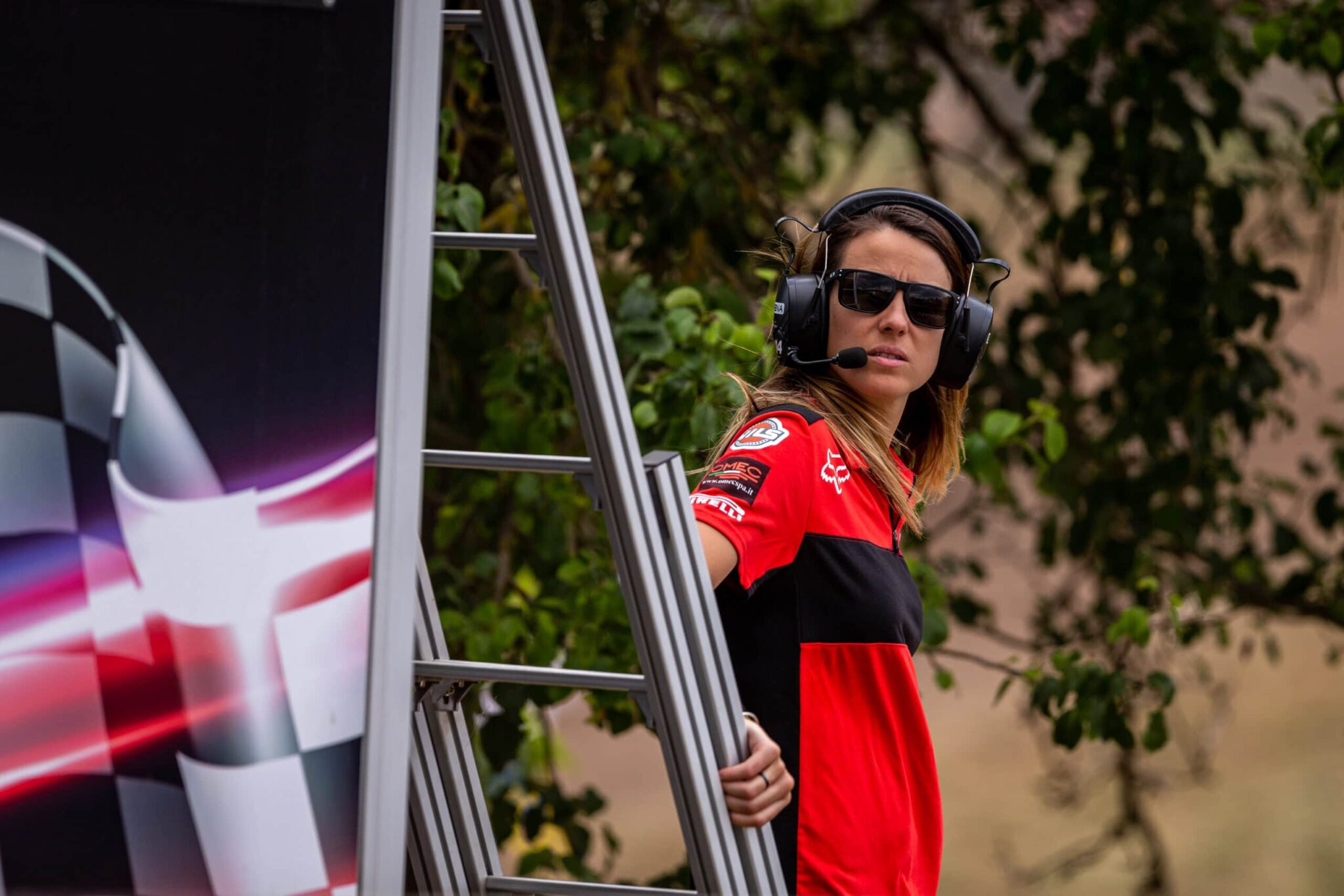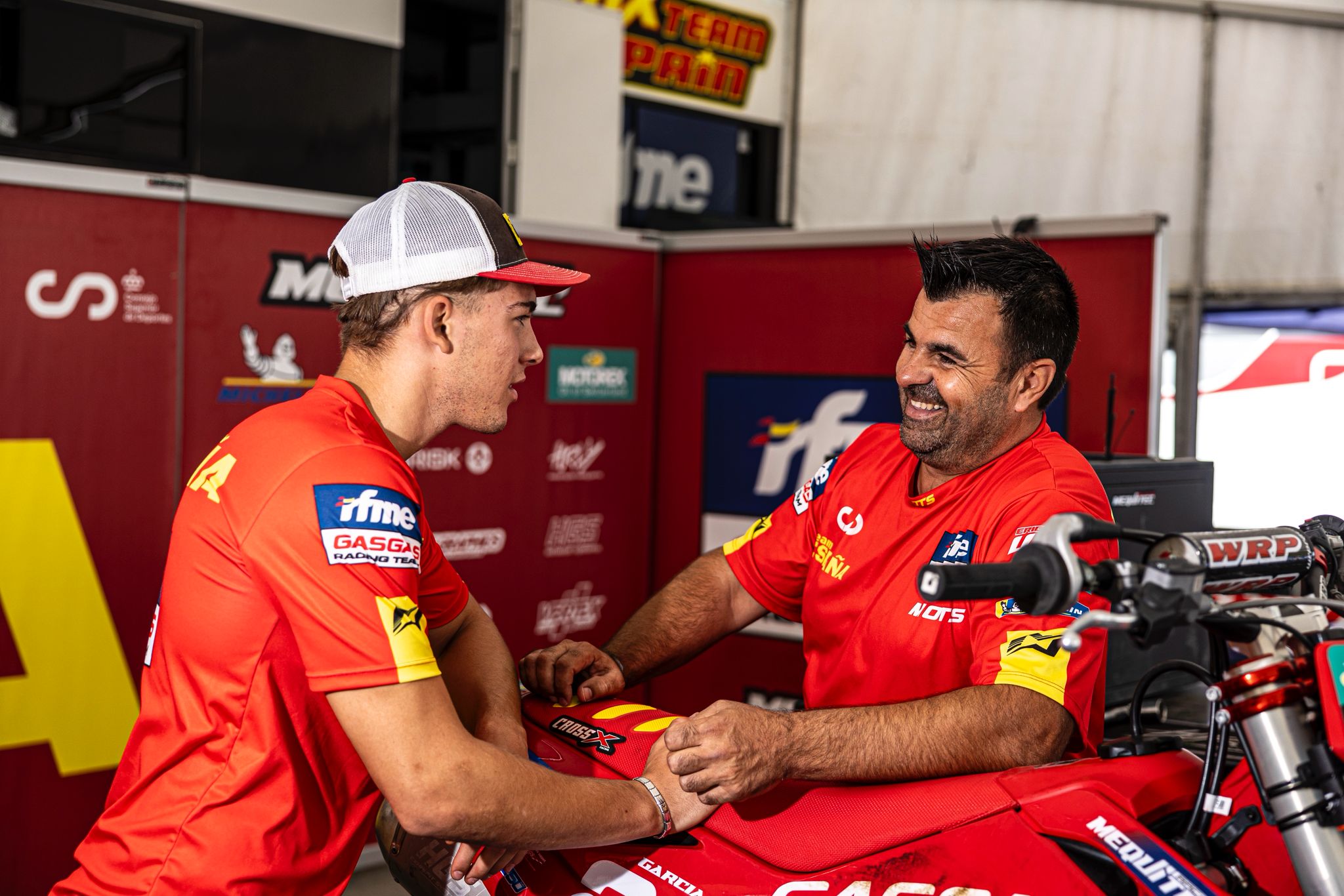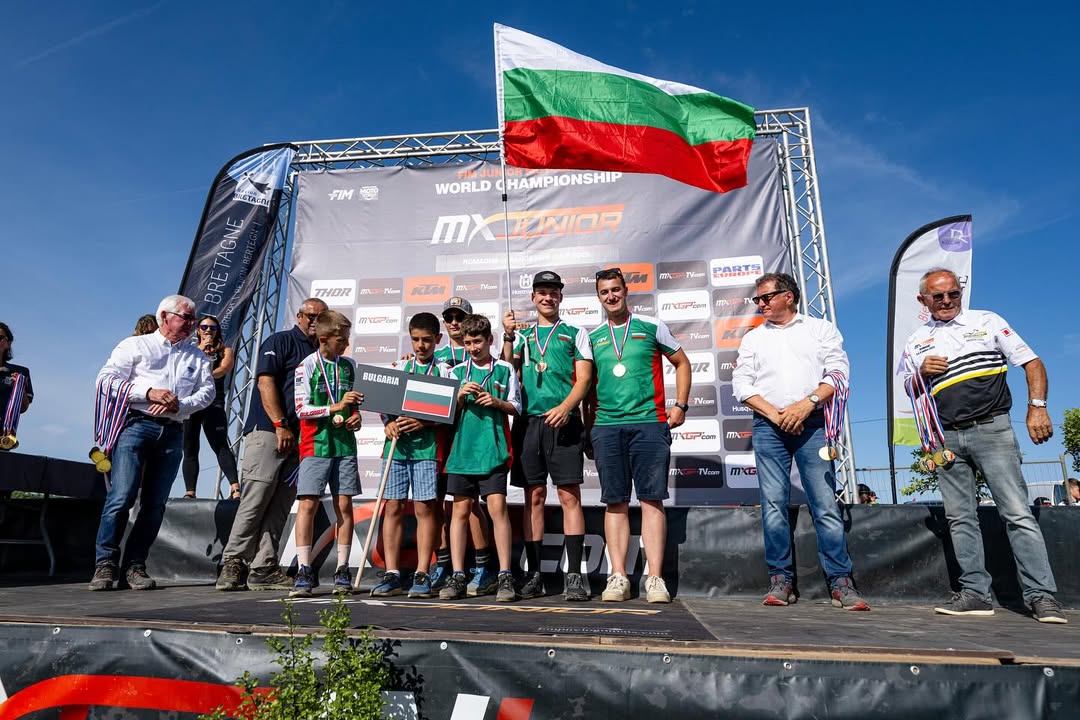After an injury setback at the German GP, Pauls Jonass has begun the road back to full fitness with hopes of returning to racing in the coming weeks as he has just got back on a bike. In this in-depth and revealing interview carried out by Kevin Frelaud, the former MX2 World Champion talks candidly about the physical and mental toll of injuries, adapting to life at Kawasaki Racing Team, and balancing racing with fatherhood.
From his reflections on the MXGP series to thoughts on the American motocross scene, Jonass provides honest insight into the highs, lows, and evolving mindset of an experienced rider still chasing podiums and wins.
Pauls, we’ll start with the most obvious thing. It’s been five weeks since your injury in Germany. How far are we from seeing you back at the GPs, and what have the last five weeks looked like for you?
Jonass: I’m getting closer and closer to getting back at the GPs. Yesterday [Tuesday], actually, I had my first day back on the bike. I went to Lommel and did a few 20-minute sessions just to feel how the shoulder is.
And for sure, it’s still not perfect. There’s still quite some work to do, but yeah, it’s a starting point. Then we’ll see how it goes. I’ll try not to rush things, just build step by step. Hopefully, I can race in Loket. If not, then we’ll see for Lommel or Sweden at the latest.
The injury was difficult in the end… At the beginning, they said it was maybe just a broken collarbone. Then later, they said there were some fractures on the scapula. So there was actually one small broken bone just next to the collarbone, and then one really close to the shoulder joint. So it just took some time to recover. But to be honest, the recovery went better than expected.
For now, the feeling generally is quite good. But, you know, it’s one thing to feel good in your daily life. The next thing is to feel good on a bike. So now I just try to get the strength back through riding. And yeah, we’ll see how far we get in two weeks.
A GP season is 20 rounds. It’s very long and it can really wear you down. It’s really tiring and exhausting. When you have some time off like that because of an injury, do you tend to double down on the physical side if you can? Or do you prefer to just use that time to do a full physical reset? How do you balance it out in the end?
Jonass: Well, to be honest, I think when you get injured, it takes more energy out of you than just keeping on racing. Especially on the physical side. Okay, you can recover or just rest the first two weeks, but then the rehabilitation starts and it’s even tougher than if you kept racing. And then, one thing is physical, but another thing is mental, you know. When you get injured, that’s always tough mentally.
Mentally, what did you go through during these five weeks in the end? I guess it was quite hard to deal with a setback, pretty much back to back.
Jonass: That’s for sure. This year I got a concussion in Sardinia. It came out of nowhere. The crash was so dumb. Even now, I just cannot understand how the hell that happened and why it was so serious.
Then I got injured again in Germany, just before my home GP, and that’s the second year in a row at the same track. That was quite tough mentally, but I just tried to focus forward and try to recover as quickly as possible.
It’s one thing when you’re busy doing something, but when you’re just chilling, you have way more time with yourself, and then for sure some creepy thoughts come into your head.
We always hear a lot about the importance of physical training, on-bike training, but we rarely talk about the importance of being strong mentally.
Jonass: Yes. And not many people understand how tough this sport is mentally, just to be on point every weekend. There are also all the ups and downs, with injuries and everything else we go through. Not many people really understand how tough motocross is and how hard racing at the highest level can be because, you know, most of the time, almost everyone is riding through some small injury, through some pain.
I was joking with someone and he said, “Can you imagine waking up one day without feeling any pain?” and I think that would be quite strange, you know. Every day I wake up and I’m like, “Oh, this hurts, that hurts” [laughs].
I’m 28 and I’m feeling really like a 50-year-old. For sure, it’s not going to get better. A few years back, I chatted with a doctor and he told me, “Unfortunately, you will have to be active all your life, otherwise it will really hurt.” And it’s true, you know, the more active I am, the better shape I’m in, the better I feel — just generally with the pain and my whole body. So it’s also a goal for me to stay fit.
2025, new team, new bike. I’d say you’ve shown once again that you have some podium and top-five speed this season. Even though, like you said, you missed some GPs because of the concussion in Riola Sardo and sometimes things didn’t really go as planned, how do you assess the results you’ve had this year so far? I would think we haven’t really seen the best version of you in 2025 yet.
Jonass: To be honest, the results have been quite disappointing this year. Okay, there were some good races but also some bad ones. Sometimes the speed was good, the results were okay, but I think I wasn’t even close to my potential or the bike’s potential. You know, what we could show and how I sometimes felt during the week.
So on one hand, it’s disappointing and on the other hand, it’s positive because I know where we could be, where we can be when all the pieces of the puzzle are put together. That’s why I’m quite motivated to put everything together and achieve even better results because I’m 100% sure that when I’m feeling good and have a bike on point, I can battle for podiums constantly.
What would you say was the missing piece then ?
Jonass: It’s always difficult when you change team, when you switch bike. Previously, for two seasons, I rode on the Standing Construct Honda. Then switching to a new bike, with a new team, it always takes some time to adapt.
I felt good quite a few times at the track during the week or even at the weekends at some points, but it’s not easy to put the whole picture together — to understand the bike better, to understand myself better on the bike. It’s just small things. Sometimes even the smallest changes you make can be a challenge to adapt to, so it’s better to have really strong knowledge about the bike. I still don’t have that much knowledge with the Kawasaki. In my position, you need some time, you need to get used to it, and I think that will come in the future.

I’m curious about the mindset you had going into this 2025 season. Looking back, you’ve been 85cc world champion, 125cc world and European champion, MX2 world champion — you’ve pretty much won in every class so far. Now you said it, you’re 28 years old. When you line up against 15 or 16 factory riders in the MXGP class, do you still tell yourself, “There is still one more title for me to chase down”? Is that goal still there?
Jonass: Yeah, for sure. It’s still a goal of mine, that’s why I do it, but it’s not the easiest goal to reach because the level in the MXGP class is super, super high. All the pieces of the puzzle have to be put together correctly. At the moment, I still have a lot of work to do to catch up with the top guys day in and day out. I can have some flashes, some good weekends, but I just need to put all the pieces together to be good throughout the season because there are 20 GPs per year. So I need to be good at all the GPs, not just once in a while.
When you signed with KRT, I guess you knew the focus would be on Romain Febvre a little bit more. You knew that since Clement Desalle left at the end of 2020, no rider has stayed more than one year with the team. Obviously, you had a great run with Tim Mathys at Standing Construct, winning the Portuguese GP last year. Yes, KRT is a factory effort, but you never really know how things are going to turn out. You know what you’re leaving behind, but not really what you’re stepping into. How did you approach that transition and what made you decide to go that route in the end?
Jonass: Like you said, I had a really good connection — and I still have — with Tim Mathys and the Standing Construct team. I was there for four years, so we had a really good relationship, achieved some good results together, and we are still really good friends. We had a great time together.
But when a factory offer is put on the table, it’s hard to say no, you know? We sat down and had a really good conversation with Tim. He wanted me to stay with the team for one or two more years because of our strong bond and connection. But I also told him that if I didn’t take this opportunity, I might regret it for the rest of my life. I said, “I don’t know if it’s going to be a good decision — we’ll see after a few years — but if I don’t take it, I’ll regret it.” Tim understood that very well.
Being a factory rider is a big responsibility; there’s definitely more pressure for sure, but it’s something every rider dreams of. To be able to ride for the Kawasaki Racing Team is huge. At the moment, I think it’s one of the best teams in the paddock.
Like you said, riders have been changing teams after one season for the last few years, but I wasn’t scared of that. I knew we could make the bike work, and I was open to the challenge. The first day I stepped on the Kawasaki, I was really happy with the bike and felt good on it.
KRT is an effective team. Of course, there’s always work in progress. We always try to make the bike better for everyone else, including from the customer point of view, so it’s challenging, but it’s a nice challenge that I really like. The team is professional, and I know I still need to change my approach and mindset a little bit, because there are so many possibilities and things we can do. I just need to be more open to request some tweaks and changes, and not be scared to ask for it, or even just try some new things.
Obviously, last year Jeremy Seewer was pretty vocal about the bike. He said it was made for Romain and he wasn’t gelling with it. What was the general feeling for you on the Factory Kawasaki?
Jonass: From the first day I stepped on the bike, I knew I could make it work. I was really happy, and yeah, straight away, I had a good feeling. I wasn’t really scared about the challenge and I’m really content with my bike. There is always some work to do with myself and with the team, and everyone knows where to improve and where to make some changes. But it’s a really good bike. We’ll work on it to get it even better for the future.
On the chassis side, I’m pretty happy. You can always improve the suspension side a little bit. I would probably like to fine-tune the engine or the mapping setups a little bit, which we’re working on. The team knows, Japan knows, so it’ll be going forward on that side.
I believe Watson, Evans, and Seewer had to ride with KYB suspensions, but you’re riding Showa this year. How come? Let’s talk about the suspension side of things.
Jonass: To be honest, it wasn’t really up to me. When I signed with KRT, they told me I’d be riding with Showa. I was like, “Yup, that’s good for me.” Even if it had been KYB, I would have signed anyway.
Sure, I’ve heard some stories from other riders in the past, but personally, I think if you put in the effort to make it work, you can make almost anything work. I mean, it’s factory equipment—whether it’s KYB, Showa, or WP. You’ve got to be open-minded and go for it, and try to make it feel right for you.
I’m happy on Showa, and I think that’s also thanks to our suspension guy Willy and the people at Showa. He and the Showa team are some of the best in the business, and I couldn’t ask for more.
I think what really matters is who’s working on your suspension. If you have a really smart guy by your side, you can even make stock OEM suspension work well. It also depends on the knowledge of the people working with you.
Most amateurs or hobby riders say, “If I had your suspension, I’d be so much faster, so much better.” And I’m always like, “Yeah, you can try it—but after one lap, you’ll come back asking me, ‘What the hell is this?’” [laughs]
OEM suspensions are really good. But people forget we race two times 35 minutes at the highest level. We need gear that lasts in really tough conditions. I won’t say what year, but I did some GPs with a stock rear shock that after 15 minutes felt as soft as a sofa [laughs].
This season has been quite strange with Gajser and Herlings being on the market so early. It seems like a lot of riders are waiting for them to sign before things start to fall into place. Is it a stressful time for you, especially since you’ve been sidelined with injury?
Jonass: Yeah, it does bring more pressure and a little more stress personally. You see all the pieces moving around, hear rumors, and you’re just sitting at home doing nothing. That’s when I pick up the phone, call Antti, and ask for a meeting to talk about the future, about the next plans. We’re still discussing things, and I really hope I can stay on the green bike next year.
How involved are you in transfer talks and contract negotiations with your agent? Do you follow what’s happening behind the scenes, or do you let your agent handle everything?
Jonass: I like to be quite involved. I always call my agent—or he calls me—and we talk things through. I’m already one of the more experienced guys in the paddock, so sometimes I just take the phone myself and call Antti if I want to discuss something. Or I’ll even send an email directly to Japan just to check in. I like being involved and not just staying on the sidelines.
I generally have good relationships in the paddock. Of course, when it comes to the final negotiations, it’s often better to stay out of it a little, but at the beginning of the process, I definitely like to be in the loop.
I’m not asking for numbers, but I’m curious—what currently defines Pauls Jonass’s value on the motocross market? I imagine your value drops a bit when you’re injured and rises when you’re on the podium. Since moving up to the MXGP class, have you noticed how much your market value has fluctuated?
Jonass: Yeah, more or less. What I can say is that it’s gone up and down quite a bit with the injuries and everything. We’re talking big swings—deep hills and deep valleys [laughs]. Somehow, it feels like I always get injured at the worst possible time, just when it’s time to start negotiating a new deal. I haven’t been the luckiest in that sense. But it is what it is, you know?
At the end of the day, I’m still happy I have the opportunity to be a factory rider, to have a factory deal, and to live this life. I get to ride my dirt bike for a living, so it’s not too bad!
I hear stories about what some riders have to do—like paying to ride—and I think, how crazy do you have to be to pay to race a dirt bike?
If it’s just a hobby, okay, I get that. But at a professional level? At GP level? It’s wild how much some riders are willing to pay just to be there.
Two years from now, I’m sorry to say it, but you’ll be turning 30, Pauls. It seems like more and more riders are extending their careers well into their 30s nowadays. Factory teams also seem to value experience more than before, not just youth. What do you think makes it possible to stay competitive in MXGP after turning 30?
Jonass: I think a lot of it comes down to experience. The bikes today are really good, but they’re also a bit more complex than they used to be. So it’s important to have experience—to know how to work with the engineers, how to read data, how to set up the bike properly to be competitive at the front.
Of course, there are young talents who come in and perform straight away—some guys are just incredibly gifted. But for others, it takes time to build that experience. And by the time you hit your 30s, that’s when you’ve got the most knowledge and feel for what you need.
Just look at MXGP right now—the top of the field isn’t exactly young, apart from Lucas Coenen. Romain is 33 and still at the front. Glenn is third in the championship, and he’s around the same age—maybe even 34.
The 450 is a tough, powerful bike, and having experience really helps at this level.
Would you say that after all these years, the physical side has taken a toll, or is it the opposite—like after training for 15 to 20 years, you’re really hitting your peak around the 30-year-old mark?
Jonass: When you’re young, you need to work really hard to reach the top level. But like you said, once you turn 30, you already have such a strong base to rely on. Training becomes a bit easier because your body has so much experience and so many hours logged. You’ve done so much physical prep and bike time that you can conserve energy—you don’t need to go 200% all the time to be at your best, and in many cases, that actually helps you.
I believe you’re a dad now. How has it been balancing dad life, family life, and still training and grinding to stay at the top of your game compared to previous years? And what’s the sleep pattern like?
Jonass: For me, it’s actually been helpful. I’ve always been a really hard-working guy—sometimes too much—and it was difficult for me to switch my brain off.
Now, becoming a dad, I do my work, I do my training, I give it my best, and then when I come home, I can disconnect from motocross and just enjoy time with my family. So yeah, I think it’s been a positive step for me. In the past, I’ve overworked myself many times and that didn’t do me any favors. Being a dad helps me stay grounded, more or less.
The sleep pattern isn’t too bad either. My son goes to bed quite early, around 7 p.m., so my wife and I have a couple of hours to relax before bed. We usually go to sleep around 10, and my son wakes up around 6 or 6:30 a.m. It’s actually pretty normal—more or less like my sleep schedule before I became a dad.

Whenever you go back to Latvia, do people recognize you like, at the supermarket? Are you a well-known athlete over there? I’m not sure someone like Romain Febvre would be recognized if he went shopping in France. Unless you’re Mbappé, you can probably go unnoticed. How is that for you in Latvia?
Jonass: Latvia is a much smaller country, and I think in general, people follow sports more closely if an athlete is successful. I’ve raced on the world stage and had some good results, so I’ve been on TV quite a bit. I also won a few awards in Latvia—like Sportsman of the Year. So yeah, sometimes people recognize me at the supermarket. It’s definitely not the same as Ronaldo or Mbappé going shopping, but it does happen [laughs].
I haven’t actually been back in Latvia much over the past few years, so maybe it would feel a bit different if I went now. But yeah, people follow motocross quite a lot over there.
That must be pretty cool though—going to the shop in your own country and having people or kids saying, “Hey Pauls, good job!” Do you like that kind of attention, or are you more of a stay-in-the-shadows kind of guy?
Jonass: The thing is, Latvians are generally quite shy. They’re not as outgoing as, say, French or Spanish people. They wouldn’t usually come straight up to you for a chat. Most of the time, they’ll just be standing behind a corner pointing and whispering, “Is it him?” [laughs] Latvians are more like that.
Do you follow much of what happens in the U.S.?
Jonass: Yes, I listen to podcasts, I read interviews, I keep up with the results—things like that.
Then I have a follow-up question. The platform they have over there is next-level—the way they promote the championship, the riders, how they bring in people from outside the industry, how they attract sponsors, and how the money flows. Obviously, the market is different in the U.S., but I believe the promoter plays a huge role in how the sport is growing there. We have a great platform in Europe, don’t get me wrong—but considering we’re supposed to be the World Championship series, shouldn’t we be a step ahead of where we actually are?
Jonass: Yeah, for sure. I always say that in the U.S., they know how to promote just about anything. They could sell you anything for a lot of money. This year, the racing outdoors has been amazing—but it hasn’t always been like that. Some years, it was actually kind of boring.
But when you watch it on TV, they promote it so well. The announcers make it sound so exciting that you get completely drawn in—and that’s crazy.
In Europe, it feels like it’s been the same thing over and over for the past few years. So yeah, I think it’s time to step up the game a little. I’m not the one in charge, and I don’t know what the exact solution is, but looking at what they’re doing in the U.S., it really seems like they’re doing a great job.
If you could change something about MXGP, what would it be? Let’s say it can’t be related to prize money.
Jonass: Well, prize money is definitely important for some riders, but that’s not even what I’m focused on here.
When I was a kid, I remember going to the first GP of Latvia in 2009. There was only MX1, MX2, and maybe a veterans’ class. On Saturday morning, there were two free practice and time practice sessions. I remember being at the track early, waiting to see them throw down laps, send big whips—it was exciting. And then Sunday morning came, and I was so hyped to see the real racing.
Now, there’s just too much racing over the weekend—with all the EMX classes, MXGP, and the qualifying race. By the time Sunday arrives, everyone is already burned out. Look at me: I’m at home injured, and I can turn on the TV at 9 a.m. on Saturday and watch racing all day long without ever leaving the couch.
I know the EMX series are really important—but maybe it would be better to keep all that on Saturday, and go back to a one-day format for MX2 and MXGP on Sunday. That way, people would get excited again to watch the big guys race. Right now, there’s just too much going on, and the main classes kind of loses its impact.
I also think they should prioritize MXGP and MX2 more—just for the sake of track preparation. With so many EMX races, there’s no time to properly prep the track. So by the time we go out, the track is usually in rough shape, and it doesn’t make for good racing.
Is the qualifying race still relevant in your opinion, considering there’s already a time practice session and barely more than 30 riders on the gate at most races? It’s like you get to qualify for a qualifying race in the end.
Jonass: For me, we don’t need it. And I think even from a spectator’s point of view, time practice is more exciting to watch. You get to see riders go all out for a single lap—it’s actually quite thrilling. Even on TV, time practice looks great.
But everyone’s pushing for the qualifying race just to get more people to come on Saturday and to sell more tickets, so I can understand that perspective too. It’s a tough topic, honestly.

Have you been following Jorge’s debut in the U.S.? What’s your take on it?
Jonass: Yeah, of course I’ve been following it. It’s been quite difficult for him, and I can understand why. He’s on a completely new bike—he spent his entire career on Austrian bikes, and now he’s on a Japanese one, which is a big switch. Then you add the new tracks, a different lifestyle, a whole new continent… it’s a massive adjustment.
He also got injured during Supercross. I think he just needs a bit of time. We’ve already seen some flashes of his potential in the last few races. Once he puts all the pieces together, I think he’ll be really good.
Of course, it’s going to be extremely tough to beat Jett—he’s on another level right now—but I believe Jorge is capable of running in the top three.
What bothers me is seeing American fans talk trash about MXGP because of Jorge’s current form. They’re like, “See? The level in GPs is so low.” But the people who’ve raced against Prado or even just seen him ride on TV know he’s not showing his true level at the moment. He just needs to find his feets.
For sure, everyone expected more from him—even myself. I thought he’d be a bit better. But I think we underestimate how massive the challenge is and how different everything is for him. Just switching bikes alone is a big deal. I know this from experience—when I was younger, I only rode on Austrian bikes, and when I made the switch to a Japanese bike a few years ago, it was tough at first. It takes time.
So yeah, I think he’s going to find his rhythm and settle in soon. Outdoors has been really hard for him. Nobody expected much from him in Supercross, which is understandable, but outdoors? Yeah, most of us thought he’d do better.
But again, we tend to overlook how huge the transition really is.
When you see Jorge, Guillod, and Paturel racing the 450 Outdoor Championship this year, do you think: “Hey, I’d like to do that too”?
Jonass: Yeah, for sure. I think all of the GP riders dream of doing at least one full season of Pro Motocross in the USA. For now, it’s not really on my mind, but you never know—maybe one day? When you see their tracks, how well they’re prepped, you just want to go there. And in general, it’s the feeling you get because you’ve been watching AMA Supercross and Motocross since you were a kid. So it’s a dream for a lot of us. But maybe when you actually go there, it’s not exactly what you imagined either.
Let’s talk about the Motocross of Nations. I believe Latvia made it into the top 10 only once, in 2019—you were part of the team. Now with Janis and Karlis Reisulis, they’re making a name for themselves, and that trio could be really solid in the coming years. You rode with them in 2023 in France, but back then Janis was still in EMX125 and Karlis was just starting out in EMX250. Two years later, does the idea of having a strong team give you extra motivation?
Jonass: Yeah, for sure. I think we can see the potential now, and it’s actually pretty big. Maybe not this year, but in a few years we’re going to have a really strong team, and that does give some extra motivation. It’s nice to see young, strong riders coming up from Latvia. It’s pretty exciting.
For this year, we’ll see how it goes. If we’re all healthy—myself, Janis, and Karlis—there’s a good chance we’ll make the trip to the U.S. It’s a pretty expensive one for our small Latvian federation to cover all the costs. We’re not the biggest federation out there.
When it’s in Europe, the government or the federation usually covers almost everything. But when it’s overseas, like in the U.S., the budget for just one weekend is insane. I think the plan is to try and get some sponsors on board to help the federation and the government put a budget together.
How many people are part of the Latvian MXoN team? With Team France, it feels like we send 50 people to Des Nations [laughs].
Jonass: Oh yeah, but France is crazy [laughs]. You guys have won the event quite a few times, so I guess it makes sense—you can afford to spend the money, and that’s fine. For us, it’s usually just the three riders, the mechanics—who are from the teams—and maybe three or four extra people like the team-manager and so on. Maybe a few more if it’s in Europe, but not that many more.
I hope we’re not going to fight over this one, but I want your opinion on my two cents. If MXGP was truly the pinnacle of our sport, we wouldn’t need the Motocross of Nations. Why? Because there’s no MotoGP of Nations that I know of, no Formula One of Nations either, since those world championships already showcase the best athletes in the world. So here’s my question: hasn’t the Motocross of Nations simply become an MXGP vs. AMA race for glory?
Jonass: That’s actually a good question—and a tough one. What’s true is, if the American guys don’t show up to Des Nations, who really cares? It basically turns into a regular MXGP race at that point, and the hype just isn’t the same anymore.
On the other hand, when you go to Des Nations, it’s massive. It’s clearly the biggest event of the year. It’s unbelievable. But at the end of the day, it’s mostly MXGP riders plus a few guys from America. Well, now we have the Lawrence brothers too, which spices things up. But sometimes, you can’t even send your best riders. Take France, for example! A few years ago, you had like four really strong MXGP guys, and you could only send two to the Motocross of Nations. So in the end, are we really seeing the best riders?
Slovenia hasn’t done a single Motocross of Nations in the U.S., yet Tim Gajser is one of the best 450 riders in the world.
Jonass: True. But they also know they’re not going there to win, because they don’t have the team for it. And it costs a lot of money to send a team overseas just to try to crack the top 10—it’s kind of crazy.
The Motocross of Nations is like a history book of the sport for a lot of countries. It has so much heritage, and I think that’s one of the reasons why it still needs to be held. The event is still huge—everyone puts in so much effort. Look at all the gear brands: they make special gear just for that one event. Everything is custom-made for MXoN. It always amazes and impresses me. Everyone gets a special gear set, a custom helmet, custom graphics on their bikes… You never see that at a regular GP—maybe for your home GP, but even then, not always.
The American championship is a national championship that we end up comparing to the World Motocross Championship. In my opinion, there shouldn’t even be a comparison — the World Championship should be where the best American riders want to compete.
Jonass: The two worlds are always clashing. The Americans think they’re the best, and the Europeans believe the World Championship is the highest level. Looking at it on paper right now, I think the best riders are in the U.S. at the moment. Yes, Tim Gajser beat Jett in a moto at Matterley during the MXoN last year, but I don’t think anyone could beat him over the course of a full championship. I also don’t think anyone is close to Deegan’s level in the MX2 class this season.
If Jett came to Europe, I think he would beat everyone straight up, no matter the track. Maybe the only exception would be riding Lommel against someone like Jeffrey. If Deegan came to Europe, he might struggle in places like Arco di Trento or Saint-Jean-d’Angély. But if you send our guys over there, I believe Deegan would smoke everyone. I’m not even a big fan of his, but if I’m being realistic, I think he’s the best 250 rider right now.
I tried to write an article about anti-doping testing in motocross — I don’t know if I was brave or just plain stupid, but it wasn’t an easy task. I’m just curious: how many times have you been tested for doping in the past two or three years? And do you think that number is adequate, or should it be increased? Motocross is one of the most physically demanding sports, there are millions at stake, yet doping controls don’t really seem to be emphasized.
Jonass: Mhh. What are you even going to take to improve in motocross? It’s not like cycling. Motocross isn’t just about being the fittest — you still need talent. Of course, there are always things you could take to get an edge, but I think motocross is one of those sports where it really wouldn’t pay off that much.
Last year, I had a doping test in Teutschenthal on Saturday, right before I crashed on Sunday. I was also in the ADAMS system, where you constantly have to log your whereabouts. I was in that program for about three years, so they would show up at my house unannounced to take samples. They can knock at your door at 6 a.m., and I think they do a good job with that.
At the GPs, I wouldn’t say we get tested that often, but it still happens. I guess you can always find something to use in any sport, but I really don’t think anyone is doing anything crazy in MXGP.

Tell me more about that ADAMS system.
Jonass: I had to use an app to report where I was every day for a few years. It’s a lot of work, to be honest — it can get quite annoying. You have to specify your location every day, at every hour. If you’re not where you said you’d be and they come to check, you can get a warning.
I actually got a warning when I went to the MXoN in Ernée because I didn’t know the name of the hotel where I was going to sleep. So I just put “Ernée” in the app and forgot to update it once I checked into the hotel. After the MXoN, I got an email saying I had received a warning [laughs]. They figured out I couldn’t be in Ernée and also sleeping at my home in Belgium — so something didn’t add up.
It’s quite serious because I think you can get suspended for six months after three warnings. So you really have to follow the ADAMS program to the letter. It’s no joke.
If you could meet the Pauls Jonass from 2020 and give him one piece of advice, with the experience you have now, what would it be?
Jonass: To stay healthy. It’s crazy because when I was in MX2, I didn’t get injured that much. Okay, I had a concussion in 2016, and I tore my ACL at the end of 2018, but for the most part, I was quite healthy.
Since I moved up to the MXGP class, it feels like every year something new happens to me — it’s been a tough challenge. My advice would be to stay healthy and to listen to yourself more, to listen to your body. The thing is, injuries can come from so many different reasons, and every time you get hurt, you start asking yourself a million questions.
To close this thing off, we have a section on the website where we ask riders to recount their most WTF story from their racing career. What would be your WTF story so far?
Jonass: So, we went to the GP of Indonesia in 2017. We had a terrible race in Pangkal Pinang. We could fly out Sunday night, so we booked our flights to Jakarta, and then planned to catch a connecting flight straight to Amsterdam. We were in that small airport with Herlings, Coldenhoff, and other team members, about to board, when we were informed that our flight would be delayed by three hours. That meant we’d miss our connecting flight.
But we saw on the boards that there was another flight to Jakarta with the same airline, scheduled at the same time as our delayed flight, because it had been postponed earlier that day. People were actually boarding that plane. I couldn’t get on it, but somehow Jeffrey, Glenn, and a few other guys managed to run to the plane and get on board to fly back to Jakarta without any problem [laughs]. I had to take the delayed flight to Jakarta and book another flight to Amsterdam that cost me €2,000. We almost missed that connection too.
When we disembarked the plane, they had all the luggage on these small carts that are normally used to bring them to the carousel. We didn’t have time for that, so we picked up our bags straight from the infield and ran through the terminal to catch the next flight. If you do that in Europe, you’d probably end up in jail [laughs]. It was pretty mad.
If you sit for one evening with the riders, I can guarantee the stories will start to come out [laughs].

